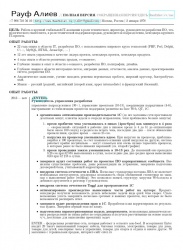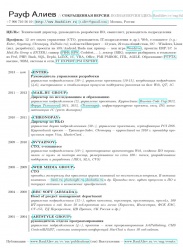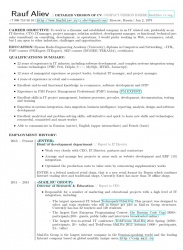Create a resume in LaTeX — how and why?
a document I'm preparing in LaTeX, not in Word. And by the time I figure out the next place, I am getting results done, and certainly not to disappear, fix them in documents that form a skeleton my CV. In my personal opinion, accuracy in creating documents for the future employer does not need to communicate with "aarami", as for the comprehension of the road on which you walk, and the direction in which decide to move on. So why am I for a summary of selected LaTeX?
a Small introduction to the subject for those who do not know what is LaTeX. This processor, at the entrance of the host markup language, the output gives the PDF with the finished document. The markup language tells the processor that the document what, where and why pictures that are automatically typeset tables, pictures, links, table of contents, index, footnotes, etc. an Ideal tool for collaboration, for complex documents with charts and formulas that can make serious adjustments in the middle for half an hour before printing and have time. Can also be a separate style as CSS in HTML. The author focuses on content, and with the publication style of the document, which includes article author. For these reasons, all of the mathematical and physical magazines are typeset in LaTeX only.
Let's look at the source code. It is in the case of my summary looks like this: http://pastebin.com/eqM1f2AY . At first glance, it is frighteningly complex, especially for those who heard about LaTeX for the first time. In fact, if you scroll to the middle, you can see the analogy with the markup language and to notice the logical partition. For example, here's a little piece of my document from another document about publish — http://pastebin.com/cy3r1paX.
Here is a document to PDF I get the result:
 http://raufaliev.ru/cv/eng/full/
http://raufaliev.ru/cv/eng/full/
I'm comfortable that I can include the source of the document under a version control system and make "brunch" for different needs — that is, to work together on a document exactly as it is on the software code. I'm comfortable that in order to in several documents to replace the circuit, I simply export the new version to the same file name on disk, and when next build will PDF catching up with the new version. If it is 1 cm longer then LaTeX will probably correct perverted to the end of the document, will replace all the links, will not allow the hanging strings, etc.
Adjusting the text one line, I "Campiglio" extended version or the abridged summary. If I need to make some of the text at once in two documents, I put it in a separate file and include a link to it from me. It is very convenient in the case summary, when you have to cook a lot of versions for different positions.
the
For recruitment agencies need Word option, as they are for customers to fill their own forms copy and paste from your CV, and PDF is not easy to do. To LaTeX in the General case, helps Converter TeX4ht he knows how to exportit in Word. In my case it is not very helpful: but any complex documents "floating" layout, it doesn't work with conditional structures, there are other restrictions. Therefore, the Word version had to be done separately — word version. But in most cases it is tolerable result.
A very convenient means of automation similarly decorated blocks are LaTeX macros, which is set with the command \newcommand. Can be any piece of document to be parameterized — that is, instead of the real blocks to frame #1, #2, #3, and then this piece to call by name, passing in curly brackets after the name of these parameters.
the
LaTeX is a great technology when:
Significant advantages of LaTeX is that almost all the "problems" with LaTeX already, someone decided, everything is fine Google. Under the problems refers to all non-standard: LaTeX does not like deviations from the best practice, but if you really need admits. But have to Google and look for yourself solutions.
The downside of LaTeX is relatively poor readability of the "source code". Control structures some bring litter the text, and the same tables without a glance at the compiled PDF to understand is not always easy. Incompatibility with HTML and Wiki, for example, allows you to apply the same blocks to display on the web, in the Wiki and in the PDF and it's a pretty common task, for example, to maintain documentation up-to-date in the printed version, in the version of the Wiki and in the public online version for partners. Converters to partly solve the problem, but you have to make a number of compromises.
As unusual experiments, I can remember trying to write in LaTeX presentations (there is a special package Beamer) and badges-business cards with QR codes (there are also special packages). In the case of presentations, you can "one-click" to generate a slide-set for a certain category of client, which is impossible in Microsoft PowerPoint. About creating presentations habré already wrote. In the case of badges, business cards are easier to automate the printing of PDF — here you will need programming skills, but to work with LaTeX, it might be easier than the programmer to generate PDF yourself. For example, for business cards I once had debugged the page with business cards (including auto-generation of the QR code means LaTeX module), and then I gave LaTeX a list of several thousand rows Surname-Name-Company-Position-Phone-E-mail, and got a PDF of thousands of pages with a fully prepared set of cards, with labels bleed, etc.
And in the end, I wanted to recommend the service WriteLatex.Com. It allows real-time to compile the document, but for starters, provides a framework that is easy to fix to suit your needs (and at the same time to understand the syntax). Such "sandbox" in which it is easy to test the technology. While writing the source document, in the next window, updated PDF. Moreover, it is possible to edit documents jointly to several persons, and it is normally "digest" simultaneous editing of the same document. Use writelatex.com allows not to put a large distribution MikTeX (Windows) or MacTex (MacOS) in order to determine how it is necessary and useful.
UPDATE: thanks to
Article based on information from habrahabr.ru
a Small introduction to the subject for those who do not know what is LaTeX. This processor, at the entrance of the host markup language, the output gives the PDF with the finished document. The markup language tells the processor that the document what, where and why pictures that are automatically typeset tables, pictures, links, table of contents, index, footnotes, etc. an Ideal tool for collaboration, for complex documents with charts and formulas that can make serious adjustments in the middle for half an hour before printing and have time. Can also be a separate style as CSS in HTML. The author focuses on content, and with the publication style of the document, which includes article author. For these reasons, all of the mathematical and physical magazines are typeset in LaTeX only.
Let's look at the source code. It is in the case of my summary looks like this: http://pastebin.com/eqM1f2AY . At first glance, it is frighteningly complex, especially for those who heard about LaTeX for the first time. In fact, if you scroll to the middle, you can see the analogy with the markup language and to notice the logical partition. For example, here's a little piece of my document from another document about publish — http://pastebin.com/cy3r1paX.
Here is a document to PDF I get the result:
I'm comfortable that I can include the source of the document under a version control system and make "brunch" for different needs — that is, to work together on a document exactly as it is on the software code. I'm comfortable that in order to in several documents to replace the circuit, I simply export the new version to the same file name on disk, and when next build will PDF catching up with the new version. If it is 1 cm longer then LaTeX will probably correct perverted to the end of the document, will replace all the links, will not allow the hanging strings, etc.
Adjusting the text one line, I "Campiglio" extended version or the abridged summary. If I need to make some of the text at once in two documents, I put it in a separate file and include a link to it from me. It is very convenient in the case summary, when you have to cook a lot of versions for different positions.
| Russian version (full) | Russian version (CD) | English version (full) | English version (compact) |
 |
 |
 |
 |
| http://raufaliev.ru/cv/rus/full/ | http://raufaliev.ru/cv/rus/ | http://raufaliev.ru/cv/eng/full/ | http://raufaliev.ru/cv/eng/ |
For recruitment agencies need Word option, as they are for customers to fill their own forms copy and paste from your CV, and PDF is not easy to do. To LaTeX in the General case, helps Converter TeX4ht he knows how to exportit in Word. In my case it is not very helpful: but any complex documents "floating" layout, it doesn't work with conditional structures, there are other restrictions. Therefore, the Word version had to be done separately — word version. But in most cases it is tolerable result.
A very convenient means of automation similarly decorated blocks are LaTeX macros, which is set with the command \newcommand. Can be any piece of document to be parameterized — that is, instead of the real blocks to frame #1, #2, #3, and then this piece to call by name, passing in curly brackets after the name of these parameters.
the
\documentclass[12pt]{article}
\newcommand{\theline}[2] { %create a macro to print a string in the summary
\item \textbf{#1} -- #2 }
\begin{document}
\begin{itemize}
\theline{2012-2013}{Company1}
\theline{2011}{Company2}
\end{itemize}
\end{document}
LaTeX is a great technology when:
-
the
- several documents have common blocks and want to edit them in one place, not in each document
the - I want to make a conditional document Assembly, for example, do not include some set of paragraphs/chapters for a particular version of a document, or to include additional. Be sure that all the links, numbering, table of contents, and so on. not "broken"
the - a lot of people working on their pieces and at the last minute, you need to consider the latest version,
the - the document is very complex (with footnotes, prekrasnymi links, pictures, tables, formulas),
the - is external data that must be collected in a PDF (for example, CSV)
the - you do not want or do not need or do not have time/forces/desires to think about the design, but do not want to give "semi-finished". LaTeX will make sure that the document looked stylish, and the author behind the content.
Significant advantages of LaTeX is that almost all the "problems" with LaTeX already, someone decided, everything is fine Google. Under the problems refers to all non-standard: LaTeX does not like deviations from the best practice, but if you really need admits. But have to Google and look for yourself solutions.
The downside of LaTeX is relatively poor readability of the "source code". Control structures some bring litter the text, and the same tables without a glance at the compiled PDF to understand is not always easy. Incompatibility with HTML and Wiki, for example, allows you to apply the same blocks to display on the web, in the Wiki and in the PDF and it's a pretty common task, for example, to maintain documentation up-to-date in the printed version, in the version of the Wiki and in the public online version for partners. Converters to partly solve the problem, but you have to make a number of compromises.
As unusual experiments, I can remember trying to write in LaTeX presentations (there is a special package Beamer) and badges-business cards with QR codes (there are also special packages). In the case of presentations, you can "one-click" to generate a slide-set for a certain category of client, which is impossible in Microsoft PowerPoint. About creating presentations habré already wrote. In the case of badges, business cards are easier to automate the printing of PDF — here you will need programming skills, but to work with LaTeX, it might be easier than the programmer to generate PDF yourself. For example, for business cards I once had debugged the page with business cards (including auto-generation of the QR code means LaTeX module), and then I gave LaTeX a list of several thousand rows Surname-Name-Company-Position-Phone-E-mail, and got a PDF of thousands of pages with a fully prepared set of cards, with labels bleed, etc.
And in the end, I wanted to recommend the service WriteLatex.Com. It allows real-time to compile the document, but for starters, provides a framework that is easy to fix to suit your needs (and at the same time to understand the syntax). Such "sandbox" in which it is easy to test the technology. While writing the source document, in the next window, updated PDF. Moreover, it is possible to edit documents jointly to several persons, and it is normally "digest" simultaneous editing of the same document. Use writelatex.com allows not to put a large distribution MikTeX (Windows) or MacTex (MacOS) in order to determine how it is necessary and useful.
UPDATE: thanks to
Комментарии
Отправить комментарий